Figure 4.
Multifactorial nature of obesity-related carcinogenesis. This involves 7 categories, which are closely related to the 14 Hallmarks of Cancer and enabling characteristics. The acronyms include: A-FABP, adipose fatty acid binding protein; CD36, Cluster of differentiation; CIMP, CpG dinucleotide island methylator phenotype; CLS, crown-like structure; CMP-1, chemoattractant monocyte protein-1; ECM, extracellular matrix; EMT, epithelial-mesenchymal transition; HFD, high-fat diet; HIF-1α, hypoxia inducible factor; HSP, heat shock protein; IGF-1, insulin-like growth factor-1; IL-1, interleukin-1; IL-6, interleukin-6; LDL, low density lipoprotein; MMT, mesothelial-mesenchymal transition; NASH, non-alcoholic steatohepatitis; NF-κB, nuclear factor kappa light chain enhancer of activated B cells; NLRC4, nucleotide-binding domain and leucine-rich repeat receptor family CARD domain containing 4; OHS, obesity hypoventilation syndrome; OSA, obstructive sleep apnoea; PAI-1, Plasminogen activator inhibitor-1, ROS, reactive oxygen species; SCFA, short chain fatty acids; SFRP5, secreted frizzled-related protein 5; SHBG, sex hormone binding globulin; TGF-β1, transforming growth factor-β1; TET, ten-eleven translocation methylcytosine dioxygenase; TKR, tyrosine kinase receptor; TNF-α, tumour necrosis factor-α; VEGF, vascular endothelial growth factor. Adapted from [18]. Cellular mechanisms linking cancers to obesity by Liu et al. [18] is licensed under a Creative Commons Attribution 4.0 International License.

